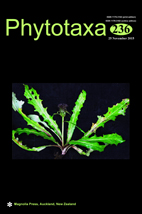Abstract
Polygonatum Miller (1754, without pagination) (Asparagaceae) is a relatively large genus containing approximately 60 taxa (Chen & Tamura 2000). The majority of species are eastern Asian (Jeffrey 1980, Chen & Tamura 2000). Phyllotaxy, cytology, and filament morphology have been recognized as important in delimiting species (Suomalainen 1947, Tamura 1990, 1991, 1993). Specimens of an anomalous Polygonatum collected by J.F. Maxwell from northern Thailand, Doi Inthanon have a general affinity to P. punctatum Royle ex Kunth (1850: 142) and have been reported as that species (Tamura 1993, Maxwell 1998), but differ in their emaculate white and longitudinally ridged perigone. Cultivated material from the same locality (BSWJ6599, Figs. 1–2) provides clear observation of the differences that are not as apparent on pressed specimens. It differs in several morphological features from P. punctatum: stem characters; phyllotaxy; leaf shape; inflorescence type and position; perigone color; and filament size, orientation, and morphology. The combined morphological differences and non-contiguous distributions of P. costatum in comparison to P. punctatum support its recognition as a new species, thus far documented only from the highest elevation in northern Thailand.

